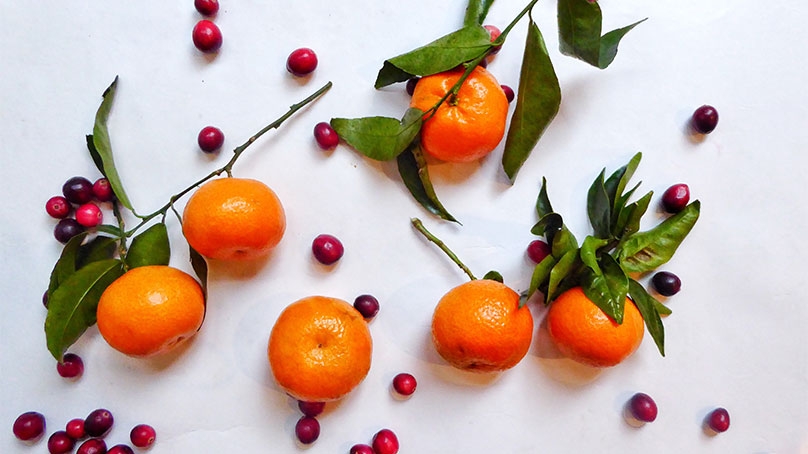You Can Still Find Fresh Fruits & Veggies In Winter
December 04, 2018 | Food Lion


Believe It or Not: You Can Still Find Fresh Fruits & Veggies in the Winter
Early winter produce is just as fresh, flavorful, and colorful as summertime fruits and vegetables are. Although summer produce is easy to pluck, peel, and pop in your mouth, winter fruits and vegetables are meant to be sliced, diced, baked, and sautéed. Keep this list handy when shopping so that you and your family continue to get your doses of healthy eating in the winter. Here's a look at December’s seasonal fruits that are also available well into the winter:
- Bose pears
- Blood oranges
- Clementines
- Cranberries
- Mandarins
- Oranges
- Persimmons
- Tangerines
Consider the Persimmon
If you’re already familiar with pears, oranges, and cranberries but you're up for something different this winter, try a persimmon. A persimmon looks like a large tomato, and its flesh tastes sweet. The fruit is filled with fiber and tannins, which help your body’s digestion and speed up your metabolism.
If you’d like to expand your winter repertoire by adding persimmon to your menu, try these three ideas.
- Frozen persimmon custard: Freeze a ripe or overripe Fuyu persimmon for at least 8 hours, cut off the top, and spoon out the sweetened, custard-like frozen fruit.
- Persimmon salad: Make a green salad and add sliced persimmon with beet, orange, and tangerine wedges.
- Persimmon crostini: Toast baguette slices in a 375 degrees Fahrenheit oven until the bread is dry and lightly golden. Layer a slice of ripe persimmon and brie topped with a sprinkle of brown sugar on each baguette slice. Put the slices of bread under the broiler for up to 2 minutes until the sugar melts.
December Veggies
Carrots are typically grown year-round. More of December’s seasonal vegetables that are available well into the winter include:
- Beets
- Brussels sprouts
- Cauliflower
- Celery
- Collard greens
- Escarole
- Kale
- Kohlrabi
- Mustard greens
- Sweet potatoes
- Turnips
- Winter squashes (all varieties)
To get the most benefit from the mega-health benefits of winter squash, it takes a little know-how to prepare and cook it. Winter squash comes in many varieties, such as pumpkin, spaghetti squash, acorn squash, and butternut squash. They’re filled with fiber, vitamin C, antioxidants, and polysaccharides to help control blood sugar, according to the Michigan State University Extension. Squash is easy to store and can be baked, boiled, or steamed.
A Different Twist on Spaghetti
If you’re curious about winter squash, you’re not alone. You’ve probably walked by the displays of hard-as-rock, nobbly, and funny-shaped vegetables year after year. This year, get to know winter squash by starting with a big yellow spaghetti squash, which will satisfy your comfort food craving while boosting your health during the cold weather. Here’s a classic spaghetti squash recipe that’s easy to prepare.
To begin, you’ll need to extract the spaghetti strands inside the squash. You can either bake it whole in the oven for an hour at 375 F or soften it up in the microwave until it’s ready to be sliced in half.
- Score the squash with a knife about 1/8 to 1/4 of an inch deep.
- Poke holes all around the squash to create vent holes.
- Microwave the entire squash for a maximum of 5 minutes (or else you’ll have serious steam buildup), and it’ll pull apart in half a lot easier.
- Once you have two halves, scoop out the seeds.
- Put the seedless halves "spaghetti" side down in a baking dish and fill with an inch of water.
- Microwave about 5 to 10 more minutes until the squash is soft.
- Scrape the squash strands out with a fork to create "noodles."
Then, eat your spaghetti squash strands alone or seasoned with salt and ground black pepper. You can also create a meal of spaghetti squash with these three ideas:
- Southwestern-style spaghetti squash casserole: Stir together drained and rinsed black beans, corn, enchilada sauce, sour cream, and shredded Monterey Jack cheese in a bowl. Pour the mixture in with spaghetti squash strands and mix. Heat the casserole in a 350 F oven until the cheese begins to melt. Top with diced avocado.
- Garlic and butter spaghetti squash: Heat a large sauté pan with 2 tablespoons of butter and 2 cloves of finely minced garlic. Melt the butter over medium to low heat until you can smell the garlic, and then add the spaghetti squash strands. Toss well. Add in Parmesan cheese and salt. For spaghetti squash with less crunch, sauté for a few more minutes.
- Spaghetti squash with meat sauce: Top spaghetti squash strands with your favorite homemade meat sauce, sprinkled with a bit of Parmesan cheese.
Visit Food Lion and search the site for a bumper crop of new recipes using wintertime squash, including soups, risottos, and bread, plus easy ways to use butternut squash.






Create Your Display Name